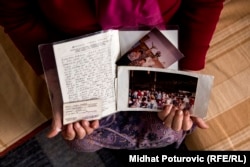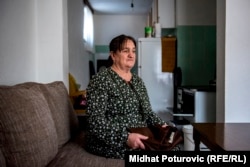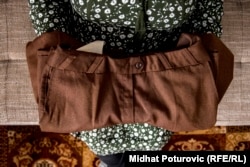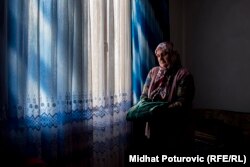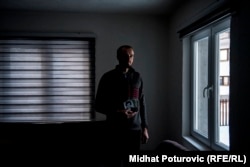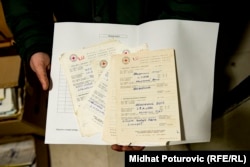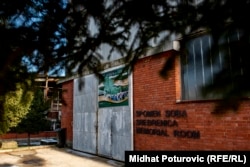A grandfather's cherished wristwatch tarnished by the elements; a missing husband's worn-out pair of pants or sweater found on him when he was unearthed; the weathered ID of a teenage son.
Such are the kinds of personal items being donated by many of the loved ones of the more than 8,000 victims of the Srebrenica massacre -- nearly all of them Bosniaks -- to the Srebrenica-Potocari Memorial and Cemetery for the Victims of the 1995 Genocide.
Hundreds of items have been collected for the exhibit in the center's museum, which lies next to a cemetery made for most of the thousands of victims of the genocidal massacre carried out by Serbian forces.
In addition to the personal objects of those killed, the collection also includes items found along sections of the so-called "Death Road" that was hurriedly trekked by hundreds of boys and men during the genocide. Some of them managed to reach freedom but many were killed and others have never been found.
Donating the items to the museum is difficult for many relatives, who often have nothing else to remind them of their slain family members. But they hope that by giving the personal belongings they can forever preserve the memory of those killed in the worst mass killing on European soil since World War II.
The memorial complex was built in the eastern Bosnian village of Potocari in 2003 to commemorate the victims of the genocide at Srebrenica, which took place at the end of the 1992-1995 Bosnian War that left more than 100,000 people dead and caused hundreds of thousands to flee the country.
Hajra Catic has never found her younger son, who was 20 years old when he was killed. The remains of her husband were found in a mass grave in 2005. More than two decades since he was killed, she is still searching for her son. Some 6,938 of the estimated 8,372 victims at Srebrenica have been identified.
"I have his wallet, I have his vehicle registration certificate. In his wallet was an ID card from my son that I couldn't find. Well, I only have those things, I have nothing more. I'll donate everything to the museum. It is of great importance that everything will be collected in one place, that means a lot."
In the mass grave at Kozluk they found the remains of Sadmir Nukic's grandfather, Asim, and a pocket watch that was important to both of them. It was the watch his grandfather promised to give him when he finished reading the Koran.
"It happened sometime in late May; he didn't succeed in giving me that watch; he took it with him. [The town of] Srebrenica was falling; he couldn't give me that gift. When he was killed and later found, I only wished to take at least that watch as a memento which he could not give me when he was alive."
Both sons of Dzejma Pasic were killed in the massacre. From the older son they found only two legs, and from the younger one nearly his entire skeleton. The elder son, Muhamed, was about to turn 19 when he was killed and the younger son, Muamer, was only 17 years old.
"I was thinking of giving these cards, the letter, and the pictures because I can never look at these. I try to take them, then I put them back...I can't look at them. I was thinking of giving them [to the museum] because after I die there is nobody [to care for them]. When we die, maybe everything will be thrown away."
Huso Halilovic recognized the remains of his father, Bajro, because he had one artificial eye. Eight years ago, his father's remains were found in a mass grave in Kamenica, near Zvornik. His father's suit was torn and was buried with him; but Huso kept the watch and comb as mementos.
"When Srebrenica fell he went to Potocari and I went across the forest. When I see these items, I'm flooded with tears; I remember how his watch was always on his hand and he was combing his hair every morning. Those are the only mementos I have."
Begajeta Nukic has preserved these pants for 25 years since her husband, Sead, was killed. This is the only thing left from Sead, who tried to escape by fleeing through the forest from Srebrenica to Tuzla. Sead's corpse has still not been found, though Begajeta and her two children are still hopeful it will be some day.
"I brought these pants; I thought he would cross [the forest], that he would come to Tuzla. But he didn't come. I waited for him a [long] time. I am still waiting for him today and I am hoping.... And then, after so many years have passed he is gone, he is gone.... The museum opens down there, there is nothing of his, there is just a name on a plaque in Potocari. Well, I wish this to be there with his name."
Rabija Avdic found her brother, Dzevad, in this sweater in a mass grave near Zvornik. This is the only memento left from the 23-year-old, who was captured at the beginning of the war and killed in the gymnasium of the Vuk Karadzic Elementary School, which had been turned into a place of internment.
"That's my brother's sweater. Well, he was in that when we found him. I can't talk about it...I want to give this sweater from my brother to the museum to show what [his killers] did."
Almost all of Ahmed Hrustanovic's male family members were killed at Srebrenica. His father, together with two uncles, were killed in Kravice. Only parts of their bodies, found in three secondary mass graves, were buried at the Potocari cemetery. The only objects left from his father are some photos and about 100 letters that are, for Ahmed, the most important mementos.
"These letters and photographs are, to me, the most important thing in the world that I have. When I read these letters they bring me back to my childhood, bringing me back to the moments when I knew I had a father. Many, many emotions are there.... Every time when I start to read these letters it awakes strong emotions in me.... Even when I talk about it now my eyes are full of tears. This is something priceless that I have. Every word that my dad wrote, every greeting and every question of 'how are you?' and 'what are you doing?'...somehow brings him back here with me to be, to live, to feel that he is here, that he was not some imaginary personality that I do not remember. Sometimes a man, in these fears and emotions, asks himself, 'Did I really have a father?' But then, when I see a letter, when I see a photo, I feel relieved. I decided to donate these letters and some of the photos to the museum. I have already given some originals and I will give some copies [of others]."










